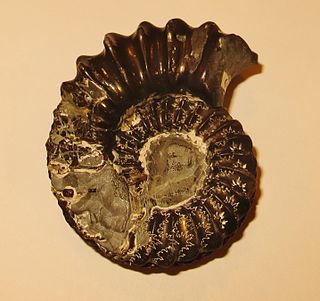
Acanthohoplites is an extinct genus of ammonites in the family Parahoplitidae that lived in the Aptian and Early Albian stages of the Early Cretaceous.
Alocolytoceras is a lytoceratid ammonite with whorls that pass during growth from round to oval, rounded-quadrate, or compressed; with about 19 deep constrictions per whorl, with as many as 21 sharp ribs in between. The shell is evolute. All whorls are visible from either side.

Alsatites is an extinct genus of cephalopod belonging to the Ammonite subclass. They lived during the Hettangian and are generally extremely evolute, many whorled. Keel broad and blunt organisms, they also exhibit a primary ribbing which is close and persistent.

Aspidoceras is an extinct ammonoid cephalopod genus belonging to the family Aspidoceratidae.

Arnioceras is an extinct genus of large, evolute, discoidal ammonite from the Lower Jurassic. The shell is normally coiled so that all whorls are exposed. Sides bear strong sharp ribs that are straight until reaching the ventrolateral edge where they swing forward and fade. The rim (venter) is keeled and free of grooves.
Dobrogeites is a genus of ammonoids from the order Ceratitida, included in the family Megaphyllitidae that produced evolute compressed planispiral shells with rounded venters, inner whorls ornamented as in Tirolites, outer whorls smooth, suture with multiple smooth lobes; Initially found in Anisian sediments in Romania.
Zaraiskites is an extinct genus of ammonoid cephalopod that lived during the Tithonian.

Ceratitida is an order that contains almost all ammonoid cephalopod genera from the Triassic as well as ancestral forms from the Upper Permian, the exception being the phylloceratids which gave rise to the great diversity of post-Triassic ammonites.

Liparoceras is an extinct fossil ammonite species from the Early Jurassic period of England, and is found in lower Lias deposits. Its name means 'fat head' and this is due to its broad shell. The venter is wide and finely ribbed with no keel and it has two rows of tubercules on each whorl.

Peltoceras is an extinct ammonite genus from the aspidoceratid subfamily Peltoceratinae that lived during the later part of the Middle Jurassic.

Macrocephalites is a genus of the stephanoceratoid ammonite family Macrocephalitidae, diagnostic of the Callovian stage of the Middle Jurassic. Three subgenera, Dolikephalites, Kamptokephalites, and Pleurocephalites are recognized in addition to Macrocephalites itself, with Indocephalites tentatively included as the fourth.
Haploceras is a genus of late Upper Jurassic ammonoid cephalopods and the type for the Haploceratidae, similar to Lissoceras but with a broader whorl section and small blunt lappets and a blunt rostrum; some species with feeble ventral folds on body chamber.

Kepplerites is a moderately evolute ammonite from the lower Callovian included in the Stephanoceratoidea.

Hecticoceras is an ammonite genus belonging to the haploceratoid family Oppeliidae, that lived during the Middle and Late Jurassic, from the Callovian. Hecticoceras may be seen as a series of some nine subgenera, beginning with the lower Callovian H. (Hecticoceras) and H. (Hecticoceratoides) and ending with the lower Oxfordian H. (Pseudobrightia) and H. (Eochetoceras). Hecticocerassensu lato and Prohecticoceras from the underlying Bathonian form the oppeliid subfamily, Hecticoceratinae.

Lytoceratidae is a taxonomic family of ammonoid cephalopods belonging to the suborder Lytoceratina, characterized by very evolute shells that generally enlarge rapidly, having whorls in contact but mostly overlapping very sightly, or not at all.
Hemilytoceras is a lytoceratin ammonite genus with round inner whorls, outer whorls becoming depressed and in some developing high lamellae (ribs) that bend forward over the venter. The type species H. immanae came from the Tithonian of Europe. The genus is known from the overall Upper Jurassic of central and southern Europe, North Africa, and western India.

Lobolytoceras is an extinct genus of ammonite in which only the inner whorls have large swollen ribs, later whorls have wrinkled growth lines which coarsen somewhat, near the aperture. The genus is known from the Lower Jurassic Toarcian of Europe. The type species L. siemensi (Denck) came from the Upper Toarcian of Germany.
Ochetoceras is a genus of ammonites, belonging to the Oppeliidae, that lived during the Late Jurassic from the early Oxfordian to the early Tithonian, and type for the subfamily Ochetoceratinae.

Hammatoceratidae is a family of lower and middle Jurassic ammonites included in the superfamily Hildoceratoidea.

Hammatoceras is a genus of ammonites belonging to the family Hammatoceratidae which lived during the Toarcian stage of the Early/Lower Jurassic between about 184 and 175 million year ago.












